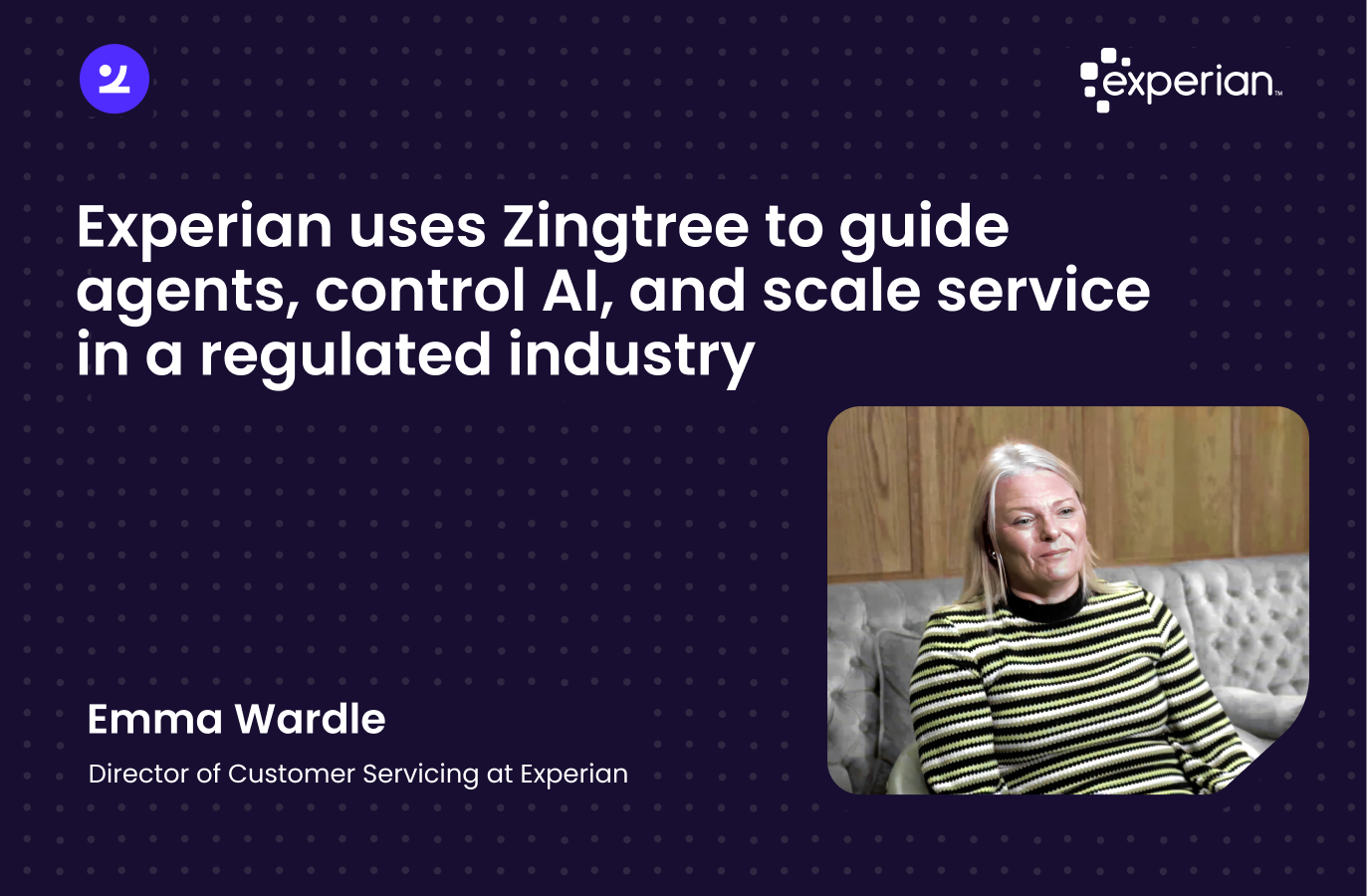Top 7 Insurance Providers Prioritizing AI Guardrails in 2025
Seven top insurers are setting the standard for safe AI adoption in customer support, using decision logic, audit trails, and real-time controls to stay compliant as they scale.

As AI adoption accelerates in insurance and healthcare, the conversation is shifting from “what can AI do?” to “what should it be allowed to do?”
That’s where AI guardrails come in: the technical and operational boundaries that ensure AI only acts when confidence is high, data is complete, and logic is compliant.
The rise of AI governance is becoming mandatory. Deterministic vs Probabilistic AI will be required for insurance compliance by 2025. What sets industry leaders apart isn’t just AI adoption – it’s control. The most forward‑thinking providers embed guardrails directly into their workflows, with real‑time confidence scores, routing logic, and human‑intervention triggers when risk exceeds thresholds. This approach enables responsible AI deployment while maintaining operational efficiency in healthcare AI compliance and insurance AI governance.
1. Zingtree's Confidence-Scored AI Agents with Built-In Guardrails
Zingtree leads the field in deploying deterministic AI agents specifically designed for regulated industries like insurance and healthcare—where automation must move fast but never go off track.
Unlike most GenAI platforms, Zingtree is architected around real‑time confidence scoring and multi‑layered guardrails to ensure every AI decision is both compliant and correct.
Confidence Score Routing: Zingtree scores every AI output before it’s delivered. Based on that score, the platform automatically chooses whether to:
- Proceed with automation
- Ask the customer or agent for more information
- Trigger fallback logic or escalate to a human
Built‑in Guardrails: AI responses are governed by business‑defined logic, access controls, and clear decision thresholds—not black‑box models.
Workflow‑Aware AI: Zingtree doesn’t just generate answers. It follows the process—enforcing policy logic at every step of claims processing, underwriting, and customer resolution.
Human‑in‑the‑Loop by Design: Teams configure when and how humans should intervene based on risk and confidence, ensuring oversight is embedded—not bolted on.
Audit‑Ready Compliance: Every decision path is logged, explainable, and enforceable—supporting insurers’ obligations under NAIC model guidelines and state‑level AI legislation.
For example, if an AI agent is only 61% confident in a claims denial, Zingtree routes it to a human for review, avoiding the risk of a wrongful decision going through unchecked. These thresholds are defined by the business, so automation never oversteps.
Key Takeaway: This approach makes Zingtree a strong fit for providers seeking to balance automation velocity with compliance‑grade safeguards—and avoid hallucinated answers in critical workflows.
2. Sutherland's Commitment to Transparent AI and Human Oversight
Sutherland sets the benchmark by implementing advanced AI guardrails, particularly through transparency and human‑in‑the‑loop processes. The company has launched an insurance AI hub to move beyond pilot programs toward production‑ready AI solutions with embedded oversight mechanisms.
Human‑in‑the‑Loop Framework: A process where human experts intervene in AI decision‑making to ensure accuracy, reduce bias, and maintain ethical standards throughout underwriting and claims processing.
Audit Trail Implementation: Sutherland maintains comprehensive logging systems that track AI decision paths, enabling regulatory compliance and accountability auditing.
Practical Applications: These practices benefit underwriting, claims processing, and policyholder servicing through measurable ROI improvements while maintaining transparency standards.
Key Takeaway: Unlike Zingtree’s real‑time confidence scoring approach, Sutherland focuses on post‑decision auditing—though both approaches emphasize the critical importance of human oversight in regulated environments.
3. Progressive's Focus on AI Compliance and Customer Accountability
Progressive advances both compliance with emerging regulatory standards and a consumer‑centric approach to AI. The company has earned recognition for transparent AI implementation in claims and customer service operations.
Proactive Regulatory Alignment: Progressive aligns AI systems with developing regulations and ensures transparency in claims and customer service workflows.
AI Compliance Emphasis: Progressive emphasizes AI compliance, but most systems still rely on post‑hoc auditing. Zingtree’s model adds confidence scoring to the front of the decision, enabling systems to self‑regulate before errors happen.
Customer Data Protection: The company adopts explainable AI mechanisms to safeguard customer data and make claims handling more accountable.
Key Guardrail Techniques:
- Real‑time monitoring of AI decision outcomes
- Customer notification protocols for AI‑assisted decisions
- Regular bias testing in automated underwriting
- Escalation triggers for complex claims scenarios
Key Takeaway: Progressive emphasizes AI compliance, but most systems still rely on post‑hoc auditing.
4. Northwestern Mutual's Ethical AI for Life Insurance Services
Northwestern Mutual focuses on the life insurance sector, making ethical use of AI central to their strategy. The company maintains high industry ratings through disciplined adherence to regulatory frameworks prioritizing fair, ethical AI use.
Ethical AI Definition: AI systems developed and managed to respect privacy, avoid unfair outcomes, and support trustworthy interactions with customers throughout the policy lifecycle.
Fair Underwriting Models: Northwestern Mutual employs explainable AI models in underwriting and policy management that can demonstrate decision reasoning to regulators and customers.
Consumer Trust Reinforcement: These practices strengthen consumer confidence and operational stability by ensuring AI decisions are transparent and defensible.
Regulatory Framework Adherence: The company’s approach aligns with emerging state‑level AI regulations while maintaining the personalized service standards that drive customer retention in life insurance markets.
Key Takeaway: These practices strengthen consumer confidence and operational stability by ensuring AI decisions are transparent and defensible.
5. Kaiser Permanente's Integration of AI Guardrails in Healthcare Insurance
Kaiser Permanente leads by embedding AI guardrails at every step of the healthcare insurance process. The organization demonstrates robust compliance with state regulations and commitment to ethical practices in healthcare decisions across their integrated delivery model.
AI Guardrails Definition: Technical, procedural, and policy controls that limit AI system actions to ensure ethical, fair, and transparent outcomes in healthcare coverage determinations.
Regulatory Environment: 46 U.S. states regulate AI use in healthcare to promote safety and fairness, making comprehensive guardrails essential for compliance.
Measurable Impact Areas:
- Faster prior authorization processing with maintained accuracy
- Improved care coordination through AI‑assisted case management
- Enhanced fraud detection without false positives affecting patient care
Integration Advantage: Kaiser's model allows for seamless AI implementation across both insurance and care delivery functions, creating comprehensive oversight that most traditional insurers cannot match.
Key Takeaway: Kaiser's model allows for seamless AI implementation across both insurance and care delivery functions, creating comprehensive oversight that most traditional insurers cannot match.
6. Travelers' Transparent and Efficient AI‑Driven Claims Processing
Travelers leverages transparency‑focused AI for claims, amplifying operational efficiency without compromising integrity. The company has earned recognition as a leader for transparent, auditable AI systems in claims processing workflows.
Operational Efficiency: AI expedites claims processing, freeing adjusters for higher‑value tasks while maintaining decision quality and customer satisfaction.
Regulatory Alignment: The company aligns with regulatory guidance on explainability, audit trails, and customer fairness throughout the claims lifecycle.
Claims Cycle Comparison:
- Traditional processing: 7‑14 days average resolution
- AI‑enabled processing: 2‑5 days average resolution
- Enhanced auditability: 100 % decision path documentation
- Customer satisfaction: Improved transparency in status updates
Key Takeaway: Unlike systems that require post‑hoc explanation, Travelers focuses on making AI decisions inherently interpretable from the start of the claims process.
7. UnitedHealthcare's Bias Mitigation and Fairness in AI Systems
UnitedHealthcare reduces bias and promotes fairness at scale through advanced AI governance. The organization manages large healthcare datasets while ensuring minimal bias and high fairness in coverage decisions across diverse patient populations.
Regulatory Compliance: Texas and Maryland require fairness auditability and anti‑discrimination measures in healthcare AI systems, driving systematic bias monitoring approaches.
Bias Mitigation Definition: Actions taken to identify, measure, and reduce unfair prejudices in AI models or outputs, especially in sensitive decision‑making domains like coverage determinations and care authorization.
Customer Benefits:
- Faster coverage decisions with consistent fairness standards
- Reduced disparities in care authorization across demographic groups
- Improved appeals processes with explainable decision reasoning
Scale Advantage: UnitedHealthcare’s vast data resources enable continuous bias monitoring and model refinement that smaller insurers cannot easily replicate.
Key Takeaway: UnitedHealthcare’s vast data resources enable continuous bias monitoring and model refinement that smaller insurers cannot easily replicate.
AI Guardrails Vendor Comparison
Key Trends Driving AI Guardrails Adoption in Insurance
The adoption of explainable AI and mandatory transparency as compliance standards for 2025 reflects broader industry transformation. Operational AI must now be governed, not just smart. Real‑time confidence scores and fallback logic are becoming standard in production systems.
Major Industry Drivers:
- Regulatory requirements (NAIC AI model bulletin and state laws)
- Consumer demand for transparent, fair automation
- The need to manage large volumes of unstructured data (80‑90 % of enterprise data)
- Risk management requirements for automated decision‑making
- Confidence-based routing is emerging as the new standard for AI deployment—especially where decisions affect coverage, claims, or compliance.
Industry Statistics:
- 84 % of health insurers use AI/ML by 2025
- 78 % of insurers increasing AI budgets
- 24 NAIC jurisdictions have adopted AI governance requirements
- 46 states regulate AI use in healthcare operations
Regulatory Compliance and Industry Standards for AI Use
Regulatory compliance is now central to insurance AI strategy, with NAIC AI model bulletin requirements driving systematic adoption of governance frameworks.
NAIC AI Model Bulletin: A nationwide regulatory guideline requiring insurers to maintain a written AI system use program focused on fair and transparent AI implementation across all business functions.
Regulatory Timeline: 24 NAIC jurisdictions adopted these rules as of August 2025, with additional states expected to follow throughout the year.
Required AIS Program Elements:
- Risk assessment protocols for AI system deployment
- Ongoing oversight and monitoring procedures
- Comprehensive documentation and audit trails
- Regular fairness and accuracy testing
The connection between compliance and reduced legal, reputational, and operational risk drives increased investment in robust AI governance frameworks across the insurance industry.
Enhancing Consumer Trust Through Transparency and Explainability
Transparent and explainable AI systems reinforce consumer trust—a key differentiator in the AI era. Insurers are discovering that transparency requirements, rather than limiting AI capabilities, actually improve system reliability and customer satisfaction.
Explainable AI (XAI) Definition: AI technologies designed to make decision‑making processes clear and understandable to both regulators and end‑users, enabling accountability in automated decisions.
Trust‑Building Practices:
- Publishing transparency reports on AI system performance
- Conducting regular fairness audits with public summaries
- Providing clear explanations for individual AI‑assisted decisions
- Offering appeals processes for contested automated decisions
Robust explainability is mandated for compliance by 2025, making early implementation a competitive advantage for insurers who can demonstrate superior transparency while maintaining operational efficiency.
The most trusted systems combine explainability with real-time confidence scoring—ensuring customers and regulators know not just what AI did, but why it did it, and when it chose not to act.
Challenges in Integrating AI Guardrails with Legacy Systems
Insurers face significant friction points when implementing guardrails, but strategic approaches help overcome common obstacles in legacy system integration.
Common Implementation Hurdles:
- Legacy system integration complexity and cost
- Poor data quality affecting AI model performance
- Talent gaps in AI governance and compliance
- Organizational resistance to new oversight procedures
Strategic Solutions:
- Investing in data modernization before AI deployment
- Cross‑training existing teams on responsible AI practices
- Implementing phased AI integration with pilot testing
- Establishing clear governance frameworks before scaling
Leadership alignment and long‑term investment commitment ensure successful AI guardrail implementation. Companies that treat guardrails as technical requirements rather than business enablers often struggle with adoption and effectiveness.
Continuous Monitoring and Performance Auditing of AI Models
Continuous oversight and performance auditing are indispensable for ethical, reliable insurance AI. Effective monitoring combines automation with human expertise to maintain system performance and regulatory compliance.
Performance Auditing Definition: Regular review of AI systems to ensure decisions remain accurate, fair, and aligned with company values and regulations throughout system lifecycle.
Essential Monitoring Practices:
- Establishing comprehensive audit trails for all AI decisions
- Running periodic fairness and accuracy assessments
- Implementing real‑time monitoring dashboards for system performance
- Creating feedback loops for continuous model improvement
Audit Trigger Events:
- Adverse customer outcomes or complaints
- Systemic errors or performance degradation
- Regulatory reviews or compliance investigations
- Significant changes in input data patterns
Successful insurers blend AI automation with human expertise to interpret rules and adapt quickly to regulatory changes while maintaining system reliability.
Conclusion
(Conclusion content is intentionally left blank to preserve the original material unchanged.)
Frequently Asked Questions
What are AI guardrails and why are they critical in insurance?
AI guardrails are policies, technical controls, and monitoring systems that ensure insurance AI technologies operate ethically, transparently, and in compliance with regulations. They're critical for protecting consumers and maintaining fairness as AI becomes more central to insurance decisions, particularly in claims processing, underwriting, and fraud detection.
How do AI guardrails help prevent bias and ensure fairness in coverage decisions?
AI guardrails require constant monitoring and fairness audits, helping insurers detect and reduce bias in automated decisions so all customers are treated equitably under regulatory guidelines. They include bias testing protocols, demographic impact assessments, and appeal processes for contested decisions.
Which insurance operations benefit the most from AI with embedded guardrails?
Underwriting, claims processing, fraud detection, and customer service benefit most, as strong guardrails improve decision accuracy, transparency, and compliance in these high‑impact areas. These operations handle sensitive customer data and make consequential decisions requiring regulatory oversight.
How do AI guardrails improve the customer experience in claims and underwriting?
Guardrails accelerate claims resolution and underwriting decisions while increasing transparency and reducing errors, giving customers confidence that their cases are handled fairly. They enable faster processing without sacrificing accuracy or customer protection.
What are the challenges insurers face in implementing AI guardrails effectively?
Insurers often struggle with integrating guardrails into legacy systems, accessing high‑quality data, finding specialized talent, and adapting to evolving regulations—but strategic planning and phased deployment help overcome these challenges while building organizational capability.
How is Zingtree’s approach to AI guardrails different from other vendors?
Unlike most platforms that rely on post-hoc auditing or loose oversight, Zingtree evaluates each AI decision in real time. Every response is scored for confidence, routed based on risk, and logged for auditability—making it one of the only deterministic AI platforms ready for production in regulated insurance environments.
.webp)

.svg)
.svg)
.svg)



